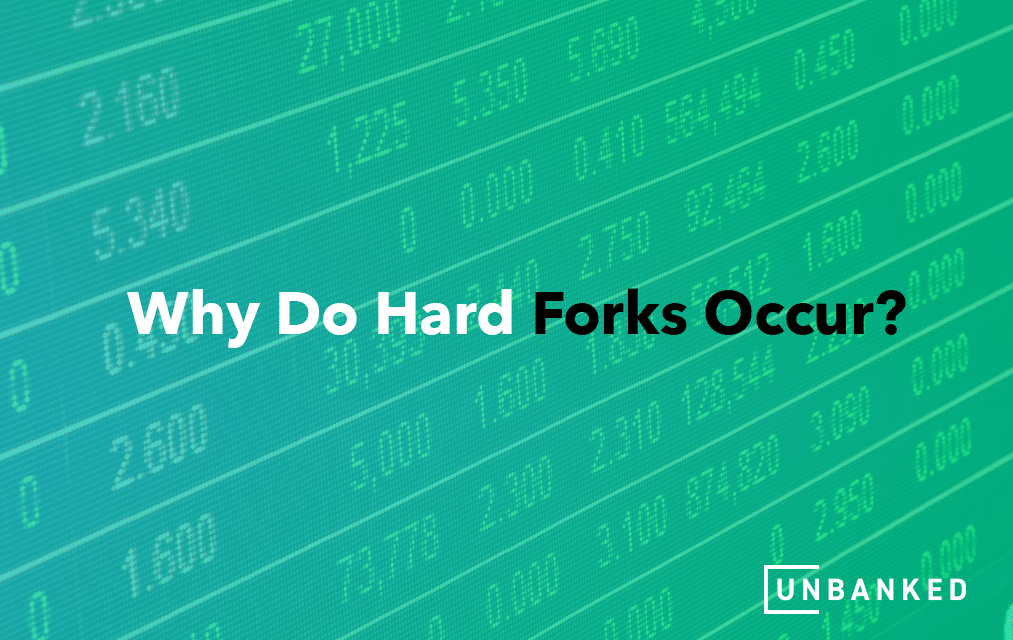In the world of blockchain, hard forks refer to any radical change in the protocols of a blockchain network. It occurs when developers fail to form a consensus over the developmental direction for a coin. As a result, a single digital currency splits into two, which means anyone using the old software will see the new transactions as invalid and vice-versa. Thus, all developers need to upgrade to the new software in order to use the new coin and blockchain.
A hard fork usually requires majority support from people holding that coin within the blockchain network. If there is a lack of consensus amongst the users, the upgrade will not be clean, leading to a break in the blockchain. Unlike soft forks, which do not cause a major structural change, hard forks lead to a permanent change in blockchain protocol. Hard forks are forward compatible, i.e., the old version of the software will be completely obsolete, and the developers will be either forced to move to the new software or keep using the obsolete version.
Hard forks happen due to the dynamic nature of the blockchain industry. Cryptocurrency codes are a constant work in progress and developers want to improve the features, functionality, and security of blockchain protocol to improve its efficiency and make it more competitive. However, this is not always easy because sometimes a simple addition of features might need a drastic overhaul in the existing code. Developers do not always agree on a particular way the cryptocurrency project can be furthered, which causes divergence in the cryptocurrency, as discussed earlier. A hard fork is an unstable time for any cryptocurrency and its value is highly volatile at this time. There have been several hard forks since the conceptualization of cryptocurrencies, and they are bound to occur as technologies advance.
An Overview of Blockchain Forks
Cryptocurrencies like bitcoin and Ethereum are powered by a blockchain — a decentralized open-source software. A blockchain fork can represent either radical or minor changes, can stem from either community members or developers, and is an essential upgrade to the network.
A fork requires node operators, which are machines that help validate transactions on the blockchain, to upgrade protocols. In addition, each node contains a copy of the blockchain to ensure that new transactions don’t contradict its history.
Hard forks are radical upgrades that can make all previous blocks and transactions either invalid or valid. They also require every validator on the network to upgrade to the new protocol. Soft forks, on the other hand, are a backward-compatible software upgrade, and anyone using older versions of the blockchain can see the new version as a valid one.
Basically, hard forks lead to permanent chain separation — the old version is not compatible with the new one. Anyone who holds tokens on the old chain is typically granted tokens on the new one since they share the same history. A hard fork can happen for a variety of reasons.
Understanding Hard Forks & Blockchain
To understand a hard fourth, it’s crucial first to understand how blockchain technology works. A blockchain is a chain made from blocks of data, and it works as a digital ledger. Each new block is only valid once the blockchain network validators confirm the previous one. You can trace data stored on the blockchain back to the very first transaction on the network that’s — why we can still see the first-ever block on the bitcoin blockchain.
Hard forks are essentially a permanent divergence from the latest version of a blockchain. It leads to a separation of the blockchain, and because some notes no longer meet consensus, the two versions of the network will run separately.
Once a hard fork happens, the previous version continues following the current set of rules, and the new version follows a different set. Heart forks are not backward compatible — the old version no longer sees the new fork as valid.
Many people see hard forks as dangerous — there is often a chain split that occurs. If this split occurs between the nodes that validate transactions and the miners who secure the network, the network can become more vulnerable to attacks and less secure overall.
A common way that people take malicious action against the blockchain network is by performing a 51% attack. These attacks occur when a group of miners has 51% or more of the computing power used to secure a network and use that power to alter the blockchain’s history. Some networks that are a result of a hard fork have dealt with these 51% attacks where the attackers spent the same funds multiple times.
Another possible vulnerability with hard forks is a replay attack. These attacks happen when a malicious entity intercepts transactions over a forked network and then repeats the data on the previous chain. Without replay attack protection, hard forks will see both transactions as valid, meaning someone could move another person’s funds without controlling them.
Why Hard Forks Happen
If a hard fork can reduce the security of the blockchain, then why do they happen? Hard forks are necessary upgrades to improve the network as technology evolves. There are several reasons why hard forks happen — it’s not all negative:
- Add additional functionalities
- Fix security risks
- Resolve disagreements in the cryptocurrencies community
- Reverse fraudulent transactions on the blockchain
We’ve also seen hard forks created by accident. Often, these forks are swiftly resolved, and the blocks that no longer had a consensus with the blockchain fall back and then adhere to it after understanding what happened. Likewise, hard forks that add functionalities and upgrade the network typically allow those that fall out of consensus to rejoin the main blockchain.
Accidental Hard Forks
The bitcoin blockchain is one that has seen many accidental hard forks throughout the years. They are more common than you might think and often get resolved quickly enough that they are not noteworthy. Usually, an accidental hard fork occurs when two miners discover the same block at the same time. When consensus on the network it’s distributed, both will see the block as valid and continue mining on different chains until someone adds a subsequent block.
Related: NFTs vs. Cryptocurrencies
That subsequent block decides which chain stays in which one is abandoned to maintain consensus. Then, the miners move on to the longer chain because the abandoned one will no longer be profitable for mining — that block is now a fork of the network.
When these hard forks happen, the miner who discovered the abandoned block loses their transaction fee rewards. However, there would be no invalidated transactions because both blocks discovered were identical.
Other times, accidental hard forks happened due to code issues leading to short chain splits. For example, in 2013, a block had a larger number of transaction inputs than seen when it was mined and broadcasted. In that case, some nodes did not process the transactions, which led to a split. The issue was later resolved when some nodes downgraded their software, reached consensus, and rejected the larger block.
Hard Forks vs. Soft Forks
Hard forks aren’t the only way to upgrade a blockchain’s software. We also have soft forks, which are often a safer alternative and backward compatible — any nodes that don’t upgrade to the newer version will still see the blockchain as valid.
We use soft forks to add new functions and features that don’t change the rules that the blockchain follows. Soft forks often get used to implementing additional features at a programming level.
To understand this difference between hard and soft forks better, you can think of it like an operating system upgrade on your computer or smartphone. After the upgrade, all of your applications will still work on the new version — that’s how the soft fork works. In the case of a hard fork, it would be like changing to a completely different operating system.

Hard Forks – A Short History
1. Bitcoin XT: It was the first major hard fork of Bitcoin. In 2014, Mike Hearn, former senior software engineer at Google, proposed to improve the features of Bitcoin – increasing the number of transactions per minute from 7 to 24. To achieve this, he wanted to increase the block size from one megabyte to eight megabytes. Initially, Bitcoin XT became a huge success, but its craze went down in a few months as it lost user interest over time. The original website doesn’t function now, and Bitcoin XT is no longer available for its users.
2. Bitcoin Classic: In early 2016, some developers launched Bitcoin Classic because they wanted to increase the block sizes to two megabytes. Like Bitcoin XT, Bitcoin Classic also garnered the interest of developers, but similarly, it was driven into oblivion with time.
3. Bitcoin Cash: It is certainly the most famous and most successful hard fork of Bitcoin. This happened in August 2017 when Bitcoin miners changed to a protocol version to solve bitcoin’s scalability problem. They wanted to increase the block size from one megabyte to eight megabytes. But not all miners could afford to start mining eight-megabyte blocks. As a result, a philosophical split occurred and now this digital currency exists as Bitcoin and Bitcoin Cash – two very different blockchains – that cater to widely different user communities with diverse objectives. Currently, Bitcoin Cash is one of the most successful digital currencies by market cap.
4. Bitcoin Gold: This hard fork came shortly after Bitcoin Cash, in October 2017. The aim of this hard fork was to tackle the mining difficulty that had become too specialized as it became impossible to profitably mine bitcoin at home with the speed of a simple computer. The development of Application Specific Integrated Circuit (ASICs) was created specifically for bitcoin mining, thus reducing its accessibility from home. Bitcoin Gold attempted to change the hardware required for bitcoin mining to make it decentralized again. It provided a unique feature called “pre-mine” that allowed developers to mine 100,000 coins after the hard fork. Bitcoin Gold provided an opportunity to a large number of people to participate in the mining process through consumer hardware that is widely available and distributed.
5. Ethereum Classic: In 2016, a hack on the Ethereum blockchain led to the theft of $50 million worth of ether, which further rose to billions of dollars. To counter this, the Ethereum blockchain went through a hard fork to reverse the loss and retrieve the stolen ether. The newly developed ledger that retrieved the stolen ether and reversed the hack became the main Ethereum blockchain while the older version was renamed as Ethereum Classic. A majority of users chose the version that reversed the hack, but some clung to the original version. Like Bitcoin, there was also an ideological rift between proponents of the immutability of the original Ethereum blockchain and those who preferred the new version that successfully erased a cybertheft.
Hard Forks – Disruptive or Beneficial?
Since its inception, cryptocurrency was always supposed to develop and improve with time. Cryptocurrency was never supposed to be a finished product. Since then, there have been several technological innovations to add features or create new cryptocurrencies. Miners and developers usually make changes in existing blockchain protocol to improve existing functionalities or revert the effect of a bug or hack. And whenever there are disagreements amongst the community about proposed protocol changes, hard forks occur. However, they can also occur due to technological upgrades.
Hard forks can be disruptive for a short time, especially when the change is happening – the digital currency is highly volatile and unpredictable at that time. However, when we see the big picture, it has been largely beneficial for the crypto markets and community – as hard forks have led to the creation of new cryptocurrencies, improved existing functionality, erased bugs, and tacked hacks.At Unbanked, we firmly believe in the potential of blockchain technology and that cryptocurrency is disrupting the traditional market and banking system. With new users every day, the crypto industry is witnessing unprecedented growth with opportunities for everyone. Visit us today to get the best out of the booming crypto market.





